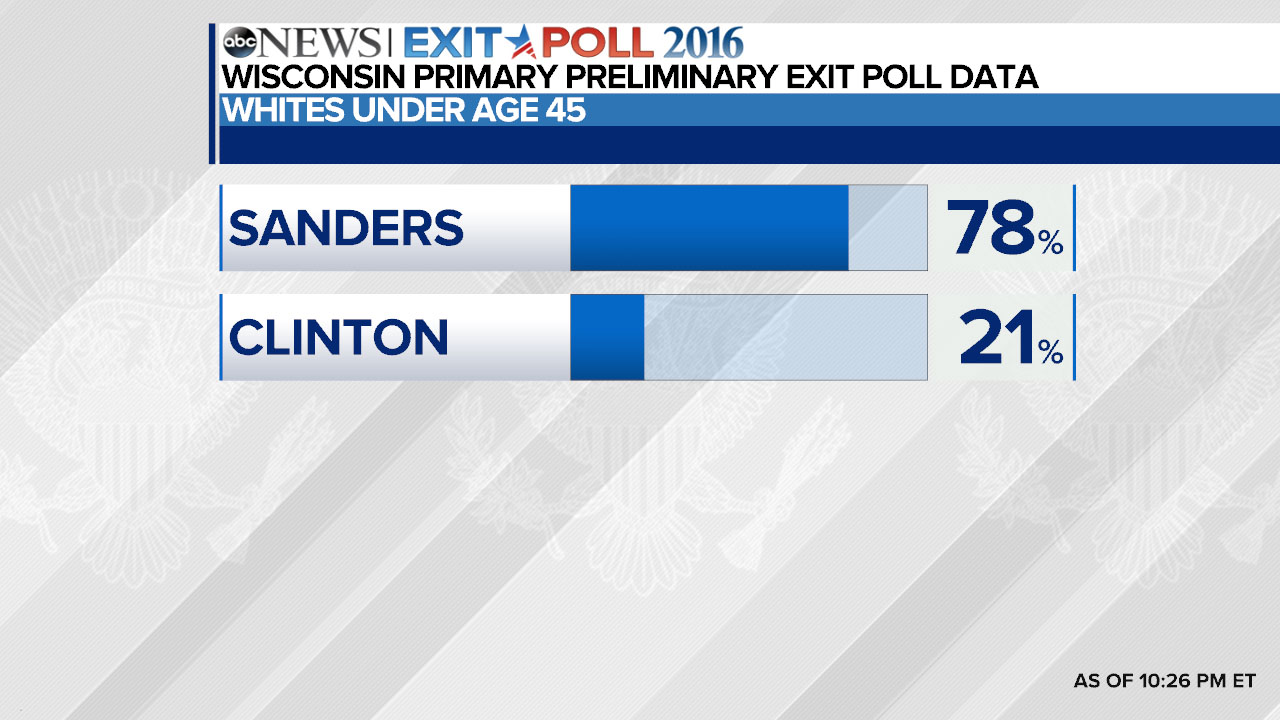Democratic Primary Exit Poll Analysis
Here's a look at who voted in tonight's Wisconsin primary and why.
— -- Who turned out in Tuesday's Wisconsin primary and what motivated their votes?
Preliminary exit poll results in the Democratic race in Wisconsin suggest that Bernie Sanders benefited both from the state’s demographics and from advantages in excitement, inspiration and honesty, while Hillary Clinton pushed back with support from mainline Democrats.
Emerging Themes
Inspiration vs. electability
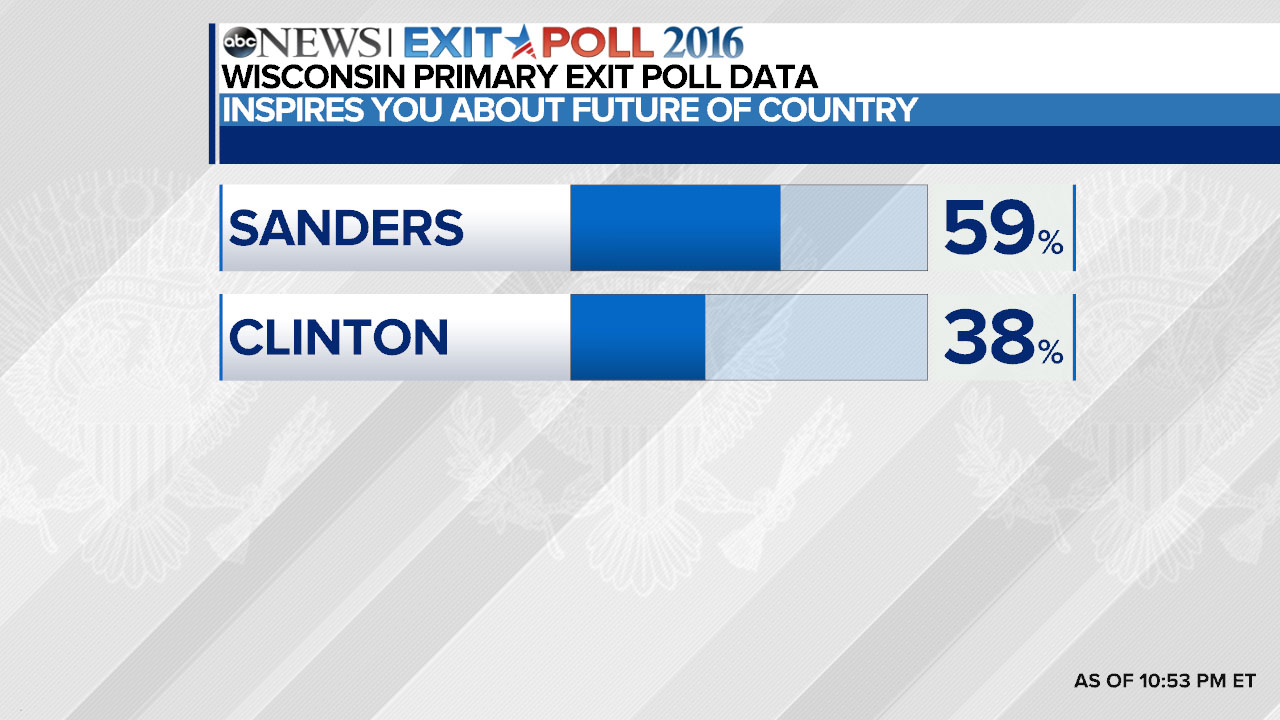
The Sanders-Clinton dichotomy appeared in results on which candidate is seen as more inspiring – more picked Sanders, 59 percent – vs. who’s likeliest to beat Donald Trump in November – more picked Clinton, 53 percent. Further, nearly nine in 10 identified Sanders as honest and trustworthy, vs. 57 percent who said the same about Clinton. And twice as many Democratic voters said they’re excited about what Sanders would do in office as said the same about Clinton, 32 percent vs. 14 percent.
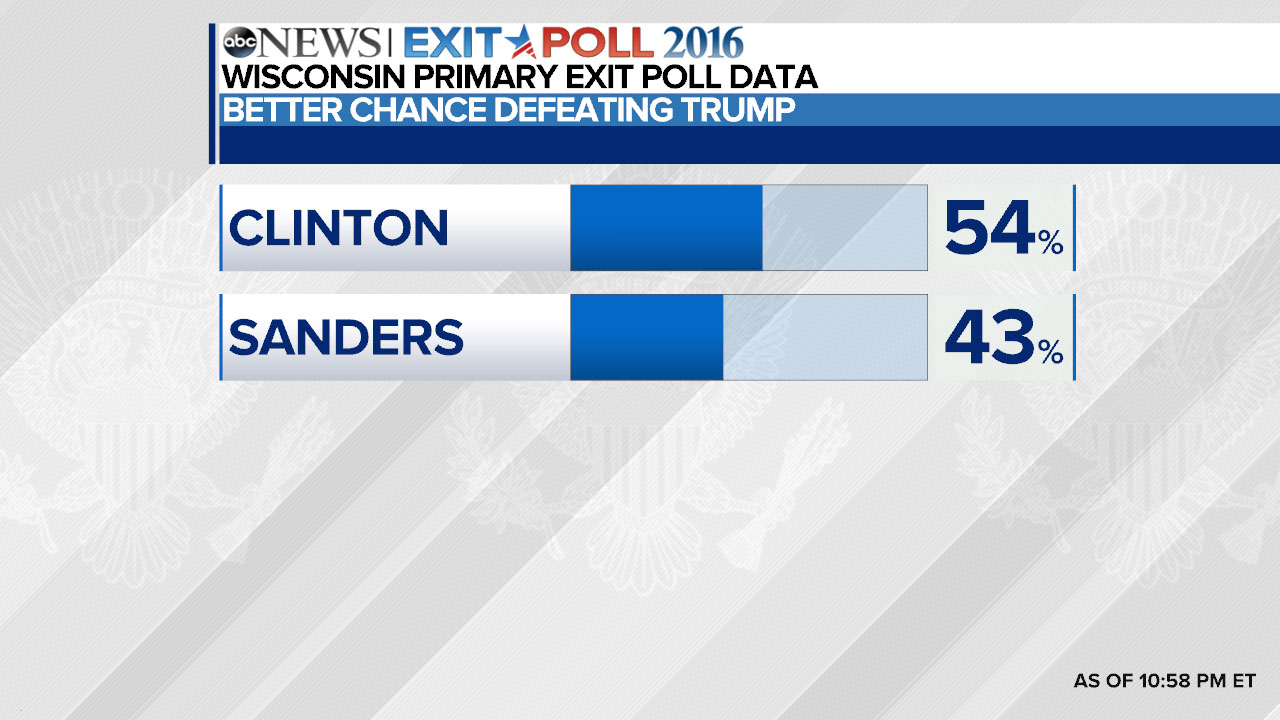
Demonstrating Sanders’ unusual strength, he ran competitively with Clinton, 51-47 percent, in who’d be the best commander-in-chief. And he won by particularly wide margins among those very worried about the economy’s direction, those who expect life for the next generation of Americans to be worse than it is today and those who think trade with other countries takes away U.S. jobs. Finally, he won 78 percent of those who favor more liberal policies than Barack Obama’s; Clinton won those who want to continue Obama’s policies, buy by less of a margin.
Excitement
In contrast to divisions on the GOP side, about three-quarters of Democratic primary voters are “excited” or “optimistic” about the prospect of a Sanders presidency, as are seven in 10 about a Clinton presidency. Excitement, though, is about twice as high for Sanders than for Clinton.
Honesty
Clinton has had problems with views of her honesty and which are apparent today in Wisconsin. Just six in 10 Wisconsin Democratic voters say she’s honest and trustworthy, vs. about nine in 10 who say so about Sanders. That’s among Sanders’ highest honesty ratings in any primary to date, even approaching his rating in his home state of Vermont.
Race
Whites account for more than eight in 10 Wisconsin Democratic primary voters in preliminary exit poll results, well above the 60 percent they’ve averaged across the 2016 primaries. Nonwhites make up fewer than two in 10 voters, including just one in 10 who are blacks – far below their average levels this year, 40 and 26 percent, respectively.
In previous primaries, whites have voted 50-48 Sanders-Clinton, vs. 72-26 percent Clinton-Sanders among nonwhites. Sanders won whites in recent primaries in North Carolina, Missouri, Illinois and Michigan, though he lost them in Ohio, Florida and Mississippi.
Qualities
Sixty-three percent of Wisconsin Democratic primary voters said they were looking chiefly for a candidate who “cares about people like me” or who “is honest and trustworthy” (eight points more than average in previous contests) and Sanders won these groups by wide margins, with 70 percent and 82 percent support, respectively, exceeding his usual levels in both cases. Clinton came back with broad support among voters who cared more about experience or electability.
Fewer, four in four in 10, call electability or experience most important, voters among whom Clinton’s dominated. Combined, honesty/empathy voters have outnumbered experience/electability voters on average in 2016, with an even larger than usual margin in preliminary exit poll results today.
Ideology
Two-thirds of voters in Wisconsin say they’re liberals, including a quarter who say they’re “very” liberal, both on pace to break records in Wisconsin Democratic primaries back to 1976. In 2008, only 46 were liberal and 16 percent were very liberal. Sanders has done much better so far among liberals than he has among moderates and conservatives. (Only a quarter of Wisconsin voters say they’re moderates, on pace for a record low and well down from 40 percent in 2008).
Partisanship
Policy fit
Fewer than six in 10 voters say Clinton’s views on the issues are about right, vs. nearly two-thirds who say so of Sanders. That’s a flip of the average of previous primaries, where Clinton’s averaged 64 percent, Sanders 55 percent.
Trade
Trade was a potent issue for Sanders in his surprise win in Michigan and helped him make Missouri and Illinois agonizingly close, though, Clinton turned things around in Ohio. In Wisconsin, more than four in 10 think trade takes away more American jobs, while fewer than four in 10 think it creates more jobs.
Economics
Three-quarters of Democratic primary voters in Wisconsin are worried about the direction of the economy. Nearly four in 10 expect life for the next generation of Americans to be worse than life today, vs. only a third who think it’ll be better. Sanders has done better among those who are worried about the economy in previous primaries.
Sanders benefited as well from a focus on income inequality – three in 10 cited it as their top issue of concern, vs. an average of 25 percent in previous races. And he won nearly two-thirds of those who picked it.
Realistic policies
More voters think Clinton’s policy proposals are realistic than think the same about Sanders’ policies (three-quarters vs. nearly two-thirds), but that gap is smaller than it’s been in previous primaries (76 vs. 57 percent). It’s similar to recent states – Michigan, Missouri and Illinois – where Sanders has fought closely with Clinton.
Commander in chief
Demonstrating Sanders’ unusual strength, he ran competitively with Clinton, 51-47 percent, in who’d be the best commander-in-chief. And he won by particularly wide margins among those very worried about the economy’s direction, those who expect life for the next generation of Americans to be worse than it is today and those who think trade with other countries takes away U.S. jobs. Finally, he won 78 percent of those who favor more liberal policies than Barack Obama’s; Clinton won those who want to continue Obama’s policies, buy by less of a margin.
Things to watch
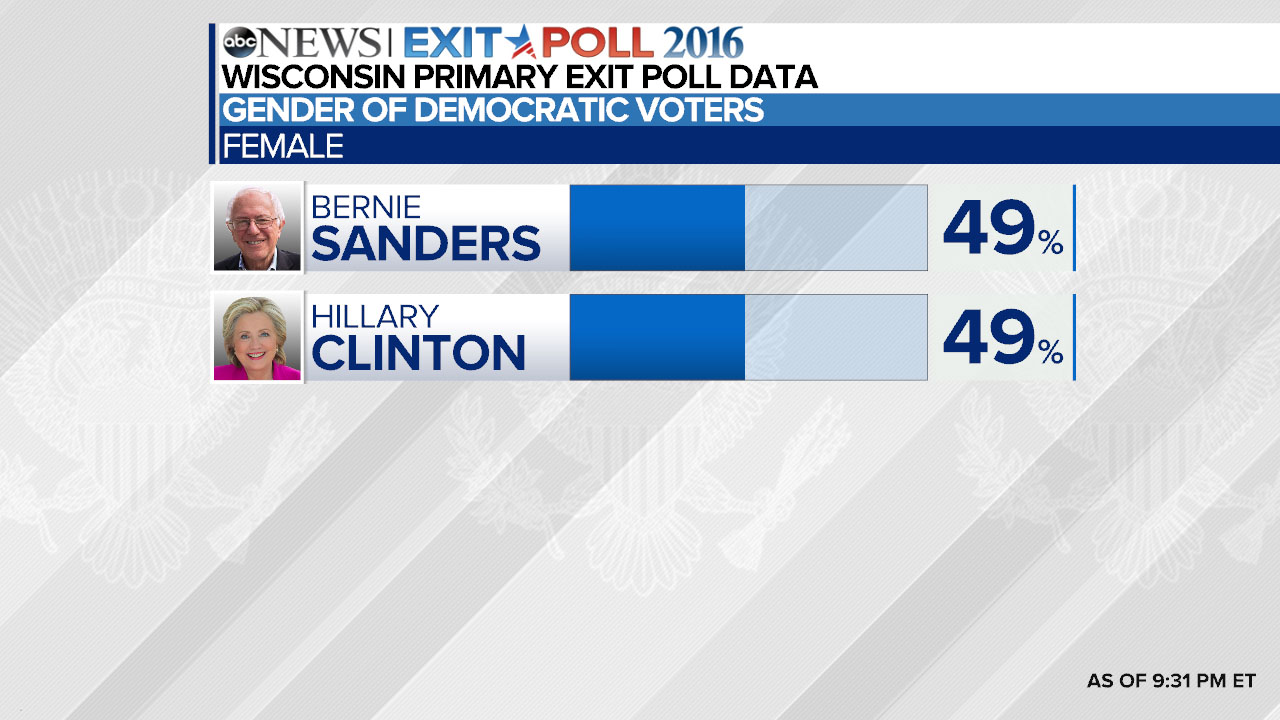
Race and Gender: Men have roughly divided between Clinton and Sanders in previous races this year (51-47 percent, while Clinton has been boosted by wide support among women, 63-36 percent. The gap’s especially striking just among whites: 55-44 percent for Clinton among white women, but a 16-point Sanders advantage, 57-41 percent, among white men. It’s a measure worth watching as this evening’s results come in, especially given the comparatively few nonwhite voters in Wisconsin.
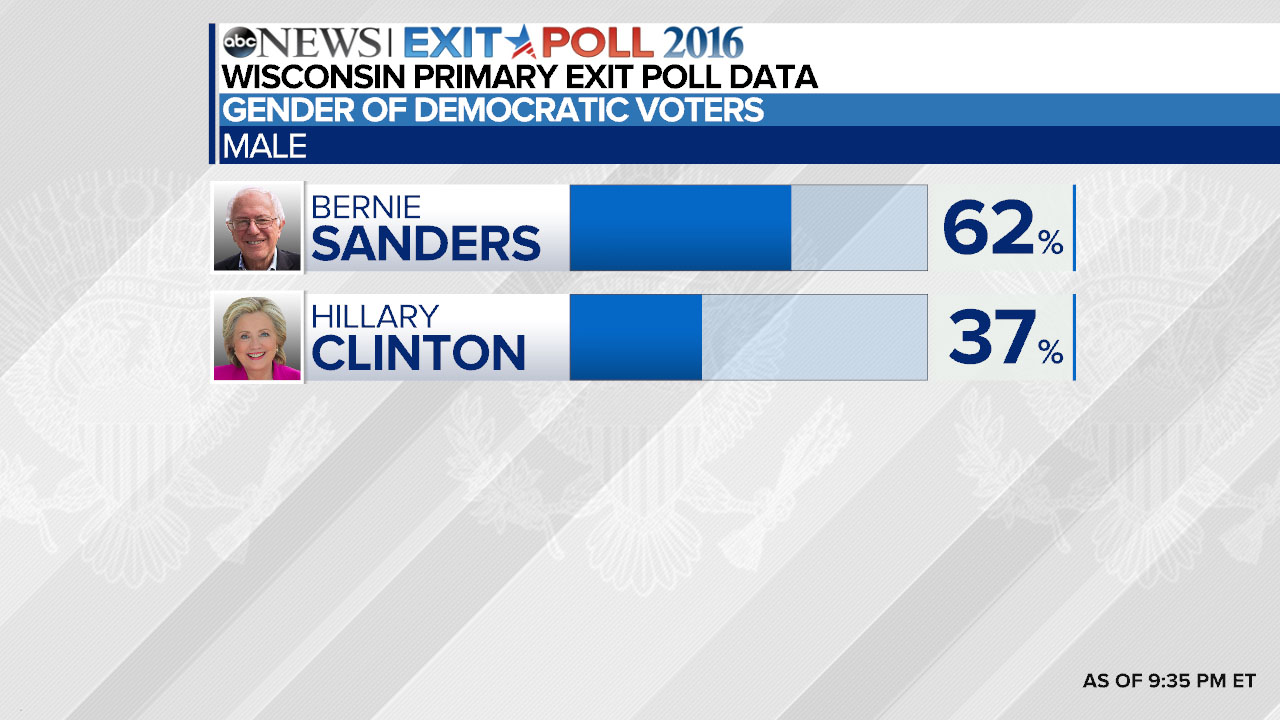
Age
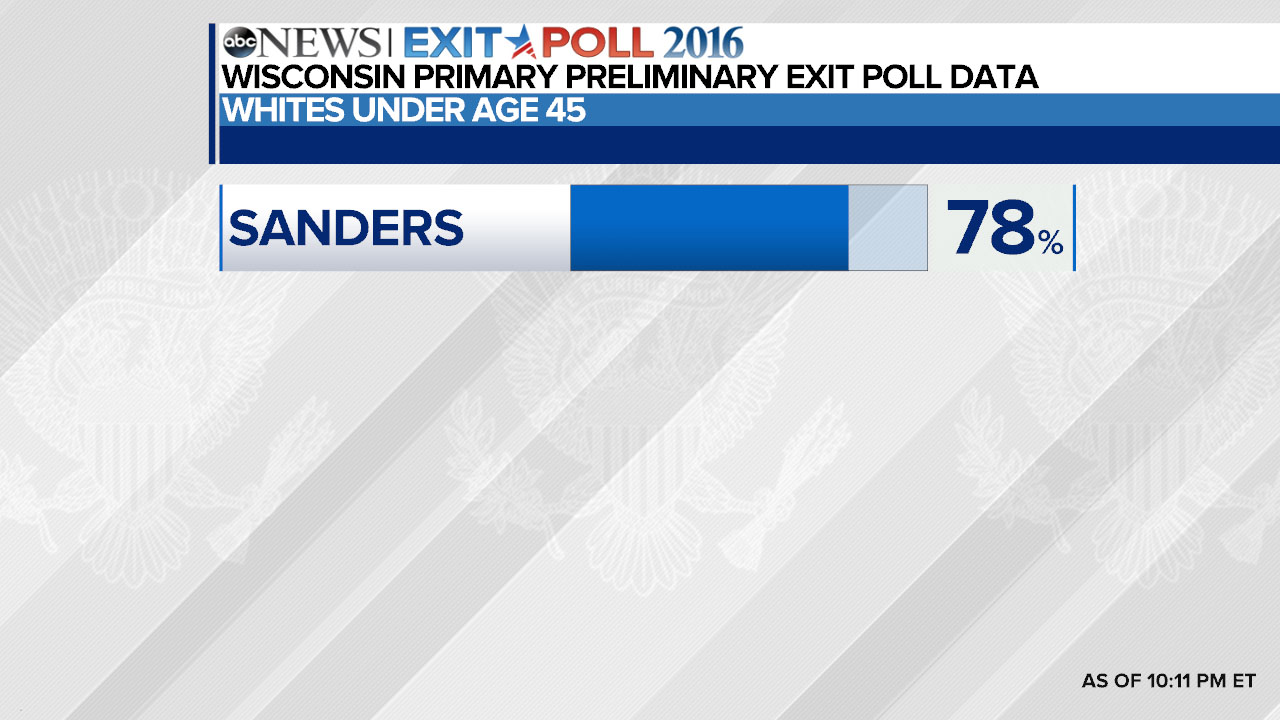
Sanders won whites under age 45 by a huge margin, with 78 percent support in preliminary exit poll results, among his best results in this group to date. Also, as in other Northern states – but not in the South – he ran competitively among young nonwhites, winning them, 54-44 percent. Sanders also won particularly broad support from men, 62 percent – better than anywhere save New Hampshire and Vermont.
Whites accounted for 84 percent of voters in Wisconsin; their large numbers hurt Clinton, given her vast support (78 percent) among nonwhites age 45 and older. But, additionally, she lost whites by bigger-than-usual margins, reflecting Sanders’ resonance on personal attributes and liberal policies.Sanders has done famously well among young voters in contests to date, winning 70 percent of voters age 18-29, vs. Clinton’s 73 percent among seniors. At 17 percent so far in 2016, turnout about young voters could end up its highest in Democratic primaries since 1976, up from 14 percent in 2008, 9 percent in 2004 and 8 percent in 2000. They make up a more than one in 10 Wisconsin voters in preliminary results.
